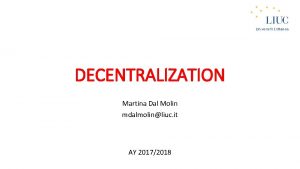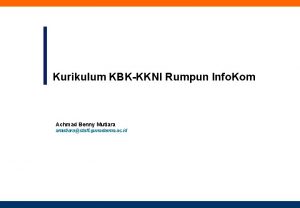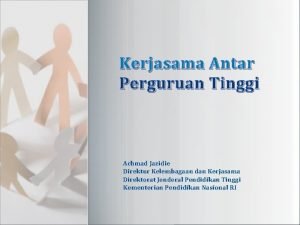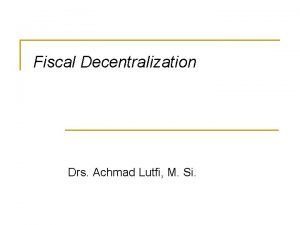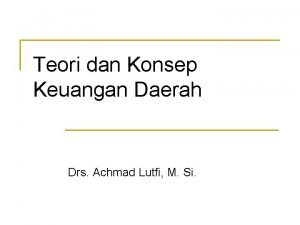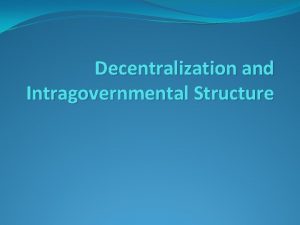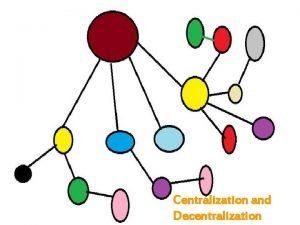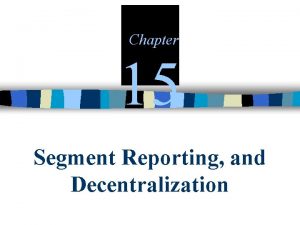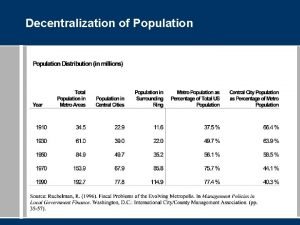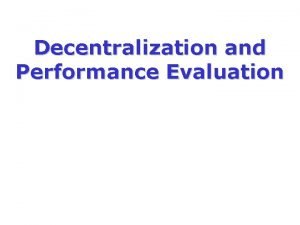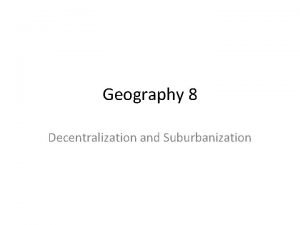Fiscal Decentralization Drs Achmad Lutfi M Si Depth
















- Slides: 16

Fiscal Decentralization Drs. Achmad Lutfi, M. Si.

Depth of Decentralization Deconcentration. q Responsibilities are moved downstream. n Delegation. q Local government are agent of central government. n Devolution. q Power to decide is moved downstream. n Proponent argue for devolution. n

Up- or Down- stream ? n n n Bottom up approach. q Emphasizes participation and efficiency. Top down approach. q Shift problem (deficit) from central government. q Decentralization. Bottom up requires genuine democracy.

Potential Problem n n n Decentralization may cause an unstable macro economy (Argentina, Brazil, China). This occurs when revenue and expenditure decentralized are unbalance. But : south Africa and Columbia managed these problem.

Definitions Fiscal Decentralization refers to an intergovernmental system where the balance of power moves toward the sub national government sector. Intergovernmental Fiscal Relations refers generally to division of fiscal powers and responsibilities among levels of government.

Advantages of Fiscal Decentralization n Move Government closer to the people. Broaden the Tax Base. Allow for alternative service delivery in social services.

Components of System of Fiscal Decentralization n Necessary Conditions. ü Elected Local Council. ü Locally Appointed Chief Officers. ü Significant Local Government Revenue Capacity. ü Significant Local Government Expenditure Responsibility. ü Budget Autonomy. ü Hard Budget Constraint. ü Transparency.

Components of System of Fiscal Decentralization n ü ü ü Desirable Conditions. Freedom from Excessive Central Expenditure Mandates. Unconditional Transfers from Higher Level Governments. Borrowing Powers.

Obstacles to Fiscal Decentralization n n n Increase in Number of Local Units of Government. Unfunded Mandates. Failure to Devise Expenditure Assignment. Too Few Tax Sources for Local Units. Failure to Develop Credit and Borrowing System. Financial Controls Retained by Central Level. Lack of Intergovernmental Fiscal System based on Transparency Rather than Negotiation and Political Influence.

Local Borrowing Advantage: Capital investments. n Problems: q moral hazard. q expectations of bailing out. q can increase instability (expenditures far exceed tax revenue). n

Solutions Increased tax powers to LG (many rich countries). n Allow LGs to bankrupt (Morocco). n Use fungible transfers as collateral (Tunisia, South Africa, Argentina)… q …but this requires high predictability of transfers (through law or the constitution). n

Local Taxing Powers Local capacity. n Upstream accountability (Uganda). n Downstream accountability (information to voters and tax payers). n High autonomy can work (Colombia, Pakistan). n

Problem with Local Taxes Vertical imbalance: q CG collects taxes more efficiently. q Solution: residents pay for what they get - and no more (no tax exporting). n Horizontal imbalance: q Some regions are richer than others. q Solution: transfers (Nordic countries). n

Transfers Targeted transfers are often used for infra structure (Morocco, Tunisia). n Fungible transfers may also work (Colombia, rich countries)… n …but require high local capacity. n Alternative may be Social Investment Funds (SIFs). n

Requirements of a SIF n n Latin American experience suggests the following: q Cost-sharing by all involved. q Demand-driven project identification. q Transparency and accountability. q Autonomy from red tape. Can increase cost-efficiency.

Conditions for Success n n n Local decision process is democratic. q (so Argentina has been more successful than China). Costs must be borne by decision-makers. . . q …so LG need to control rates (and bases) of at least some taxes. This is a reason why countries fail.
 Lütfi buday
Lütfi buday Muammer lütfi bahşi şiirleri antoloji
Muammer lütfi bahşi şiirleri antoloji Prismatic periscope
Prismatic periscope Decentralization
Decentralization Decentralization policy
Decentralization policy Decentralization and transfer pricing ppt
Decentralization and transfer pricing ppt Decentralization
Decentralization Advantages of decentralization
Advantages of decentralization Decentralization accounting
Decentralization accounting Centralization vs decentralization
Centralization vs decentralization Segment reporting and decentralization
Segment reporting and decentralization Decentralization
Decentralization Decentralization
Decentralization Dokter achmad yusuf spkk
Dokter achmad yusuf spkk Achmad benny mutiara
Achmad benny mutiara Achmad jazidie
Achmad jazidie Juan achmad yudistira
Juan achmad yudistira












